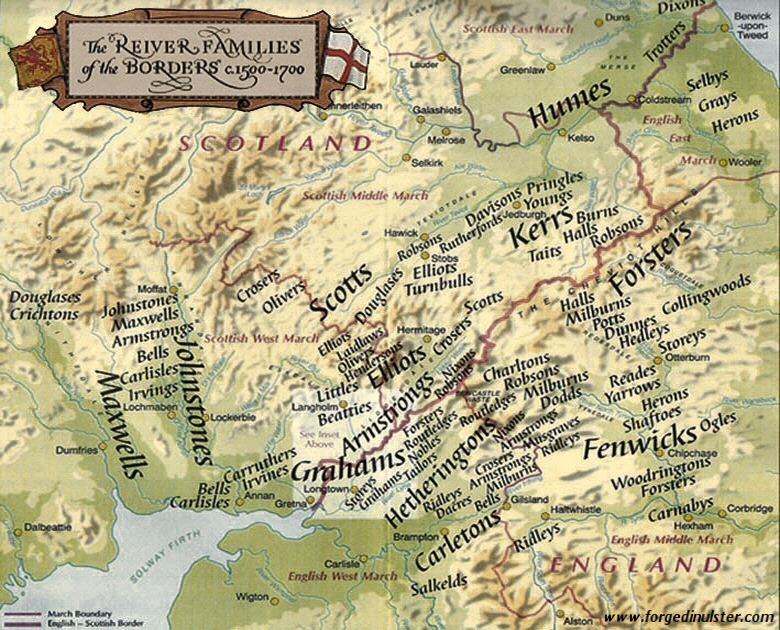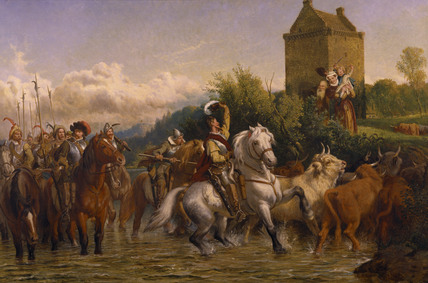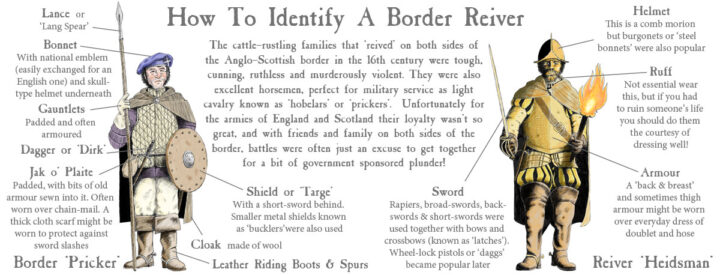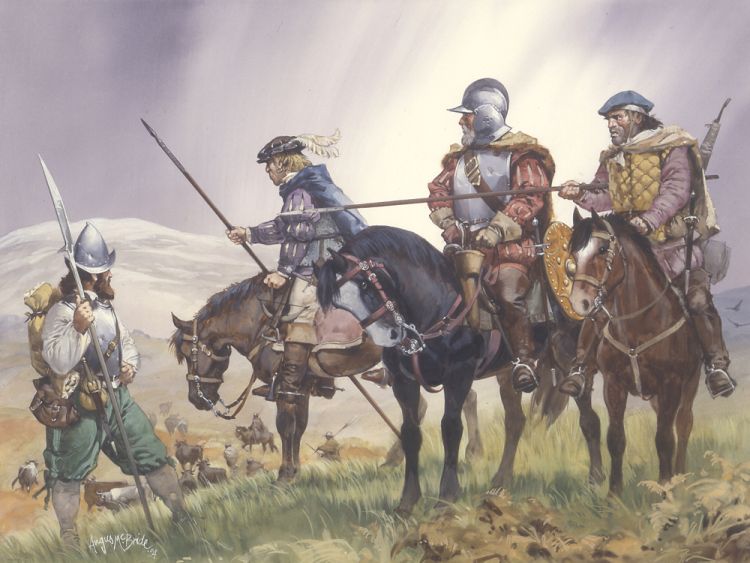Border Reiver(s) erano i guerrieri dei Clan scozzesi e le famiglie inglesi stanziati lungo il Border, la terra di frontiera tra Scozia e Inghilterra.
I Border Reivers si davano alle razzie, (furti di bestiame e saccheggi) ai danni dei loro nemici (ovvero i loro vicini di confine – gli Inglesi/scozzesi) ma anche dei clan rivali della stessa nazionalità. Facevano anche incursioni a scopo bellico, in una eterna guerriglia di confine con contorno di saccheggi e ruberie sulla strada del ritorno.
BORDER REIVER
Furono i protagonisti indiscussi del Border tra la fine del 1200 e il 1500: dalla parte scozzese le famiglie erano gli Humes, i Kerrs, gli Scotts, Armstrongs, Grahams Maxwells, Elliots, Johnstones .. mentre dalla parte inglese i Forsters, i Fenwicks, gli Hetheringtones..
Molti Borderer erano imparentati con la parte confinante, nonostante le leggi che proibivano il matrimonio con stranieri, all’occasione si dicevano
“inglesi se costretti, scozzesi per volontà
e Reiver per diritto di sangue!“
[english version]
Border Reivers were called the Warriors of the Scottish Clans and the English families allocated along the Border, the frontier land between Scotland and England.
BORDER REIVERS who gave themselves to raids, (theft of livestock and looting) to the detriment of their enemies (ie their neighbors border – the English / Scots) but also rival clans of the same nationality.
They also raided for war, in an eternal border guerrilla war with looting and robbery on the way back.
The historical period that saw them protagonists oscillates between the end of 1200 and 1500: from the Scottish side the families were the Humes, the Kerrs, the Scotts, Armstrongs, Grahams Maxwells, Elliots, Johnstones .. while on the English side the Forsters, the Fenwicks, the Hetheringtones ..
Many Borderers were related to the neighboring part, despite the laws that forbade marriage with foreigners, on the occasion they said
“British if forced, Scottish by will
and Reiver by right of blood! “

IL FAR WEST DEL MEDIOEVO SCOZZESE
La tensione nel Border era costante, anche nei periodi di pace tra le due nazioni: trovandosi in un territorio di prima linea, entrambi i governi erano indulgenti verso i clan del Border, tranne le poche punizioni, esemplari quando l’illegalità diventava intollerabile.
Così molti reivers finivano come soldati combattenti in alternativa alla condanna a morte. Gente comunque difficile da controllare, anche se inquadrata in un esercito, o perchè si mettevano a saccheggiare per il proprio interesse, o perchè cambiava schieramento a seconda dell’andamento della battaglia alleandosi con il più forte.
THE FAR WEST OF THE MIDDLE AGES
The tension in the Border was constant, even in times of peace between the two nations: being in a frontline territory, both governments were indulgent towards the Border clans, except for the few exemplary punishments, when illegality became intolerable.
Thus many reivers ended up fighting in armies as an alternative to the death sentence. People, however, difficult to control, even if framed in an army, or because they began to loot for their own interest, or because they changed sides depending on the course of the battle, to joint with the strongest.

GILNOCKIE TOWER è una tipica casa-torre. costruita lungo il Border per difendersi meglio dalle razzie dei clan rivali. Era una torre vedetta e di segnalazione riservata anche ad uso abitativo dei piccoli proprietari terrieri
GILNOCKIE TOWER is a typical tower house. built along the Border to defend itself better from the raids of rival clans.
It was a kind of lookout tower and signaling reserved also for residential use of small landowners
Gli Scheriffi del confine
Per quanto terra di frontiera il Border aveva le sue leggi in merito alle razzie e i suoi uomini delegati ad appianare le dispute. I “March Warden” dei rispettivi regni si incontravano lungo il confine nei “Giorni di tregua” veri e propri giorni di fiera, con giochi, divertimenti e momenti conviviali.
Raramente però i “March Warden” e i “Keeper” (ovvero i sorveglianti nelle torri fortificate) erano imparziali e spesso quelli scozzesi erano complici delle razzie, mostrando favoritismi verso i propri consanguinei: di fatto la lealtà tribale era più importante di ogni legame feudale di vassallaggio e non erano inconsuete le faide mortali, che si protraevano per anni.
MARCH WARDEN
Even if a borderland, the Border had its own laws concerning raids and its men delegates to settle disputes. The “March Warden” of the respective kingdoms met along the border in the “Days of Truce” real fair days, with games, entertainment and social occasions.
Rarely, however, the “March Warden” and “Keeper” (ie the guards in the fortified towers) were impartial and often the Scots were complicit in raids, showing favoritism towards their blood relatives: in fact tribal loyalty was more important than any feudal bond of vassalage and the mortal feuds, which lasted for years, were not unusual.

Sir Walter Scott
Sir Walter Scott descriveva così le “Border Ballads” “Il tratto di terra nuda e ondulata, a nord del Tyne e delle Cheviot Hills fino agli altipiani scozzesi meridionali, fu per lungo tempo il territorio di uomini che parlavano inglese, ma avevano la visione degli appartenenti alle tribù afghane; apprezzarono la poesia quasi quanto il saccheggio, e produssero una congerie così imponente di canzoni narrative locali che molti arrivarono ad etichettare tutte le nostre poesie più celebri come Ballate di confine”
La maggior parte della storia e leggende sul Border scozzese ci viene da un suo illustre figlio, Sir Walter Scott che riportò (ricamandoci anche un po’ sopra) nel suo Minstrelsy of the Scottish Border (1833) tutto ciò che, alla sua epoca, ancora si conosceva del passato, rifacendosi ad una lunga tradizione orale.
un medioevo oscuro
Egli narra di un medioevo oscuro ma anche più libero, in cui c’era appunto la libertà di muoversi per i territori (anche se non proprio con “oneste” intenzioni o per lo meno non da tutti i punti di vista) e soprattutto di esprimersi più liberamente (senza dover rendere conto ai Puritani e agli Inglesi)
Most of the history and legends about the Scottish Border comes from one of his sons, Sir Walter Scott, who reported (also embroidered a little above) in his “Minstrelsy of the Scottish Border” (1833) everything that was known to him at the time regarding the past, referring to a long oral tradition.
A dark Middle Ages
He tells of a dark Middle Ages but also freer, in which there was precisely the freedom to move through the territories (even if not really with “honest” intentions or at least not by all the points of view) and above all to express oneself more freely (without having to give an account to the Puritans and to the English)

I Border reivers cavalcavano con il favore dell’oscurità, preferibilmente nei mesi invernali, armati con lancia, spada e un piccolo scudo..
The Border reivers rode with the favor of darkness, preferably in the winter months, armed with spear, sword and a small shield
Bulli o briganti?
Un po’ tutti gli Scozzesi del Border e delle Highlands avevano un concetto più elastico sulla proprietà del bestiame.
Ad esempio se una mandria stava incustodita o mal custodita, era come se fosse a disposizione del primo che se la prendeva: l’importante era essere furtivi e non farsi sorprendere. Ovviamente il legittimo proprietario poteva nutrire dei sospetti sui ladri e rifarsi alla prima occasione comportandosi nello stesso modo. Questo sistema alla lunga però tornava a tutto vantaggio dei clan più potenti e non erano infrequenti i personaggi che tendevano a spadroneggiare.
I BRIGANTI DI STRADA
Nel secolo successivo non si parla più di reivers bensì di highwaymen ossia di briganti, diventati tali per le annose faide tra clan.
Sono considerati dal popolo come dei Robin Hood e tra le loro attività illegali rientra anche il bracconaggio..
Bullies or highwaymen?
Many Scottish Border and Highlands had a more flexible concept about the ownership of livestock.
For example if a herd was unattended or poorly guarded, it was as if it was available to the first who took it: the important it was being stealthy and not being surprised.
Obviously the rightful owner could have suspicions about thieves and make up for the first occasion behaving in the same way.
This system in the long run, however, returned to the advantage of the most powerful clans and were not uncommon characters who wanted to lord.
Highwaymen
In the following century there is no longer talk of reivers but of highwaymen or brigands, who have become such because of the old feuds between clans.
They are considered by the people as Robin Hoods and among their illegal activities there is also poaching
BORDER BALLADS
Sono molte le ballate che arrivano da quel periodo tumultuoso, ballate che si dipanavano oltre alla quarantina di strofe e servivano a intrattenere il pubblico per un buon quarto d’ora e più, e che ai nostri tempi si sono condensate in una decina di strofe se non anche meno.
Scrisse lo storico George M Trevelyan: «Erano selvaggi crudeli e rozzi, e si uccidevano a vicenda come le bestie della foresta; e tuttavia erano anche poeti che sapevano esprimere in grande stile l’inesorabile destino del singolo uomo e donna, l’infinita pietà per tutte le cose crudeli che nondimeno si infliggevano l’un l’altro. Non è stato un solo produttore di ballate, ma l’intera popolazione di taglia-gole a provare questo magnanimo dolore e il fascino consolatorio della più alta poesia “.
Non solo storie di battaglia o fattacci ma anche storielle di seduzione amorosa (più o meno consensuali ovviamente) e di romantici eroi scozzesi
There are many Ballads that come from that tumultuous period, ballads with over forty stanzas and served to entertain the public for a good quarter of an hour and more, but which in our time have condensed into a dozen verses if not less.
“They were cruel, coarse savages, slaying each other like the beasts of the forest; and yet they were also poets who could express in the grand style the inexorable fate of the individual man and woman, the infinite pity for all cruel things which they none the less inflicted upon one another. It was not one ballad- maker alone but the whole cut throat population who felt this magnanimous sorrow, and the consoling charms of the highest poetry.”[George M Trevelyan]
Not just battle stories or murdering, but also stories of love seduction (more or less consensual of course) and romantic Scottish heroes
BATTLE OF OTTERBURN
BONNY EARL OF MURRAY
BONNY MAY
CAPTAIN CAR or EDOM O’GORDON
ENGLISH LADYE AND THE KNIGHT
FAIR FLOWERS OF NORTHUMBERLAND
FAMOUS FLOWER OF SERVING MEN
GEORDIE (Robert Burns)
HIGHLAND BALOU
HOBBIE NOBLE
HUGHIE GRAME ( Robert Burns)
JOCK O’ THE SIDE
JOHNNIE ARMSTRONG
JOHNNY THE BRINE
LAMENT OF THE BORDER WIDOW
LITTLE MUSGRAVE
LONG LANKIN
MACPHERSON’S FAREWELL
PARTING GLASS
WILLIE MACINTOSH or BURNING OF AUCHINDOWN
dal 1600 (from 1600)
GEORDIE (versione settecentesca)
GILDEROY
Link
https://englandsnortheast.co.uk/border-reivers/
http://sommervillehistory.blogspot.com/2016/04/rievers.html
